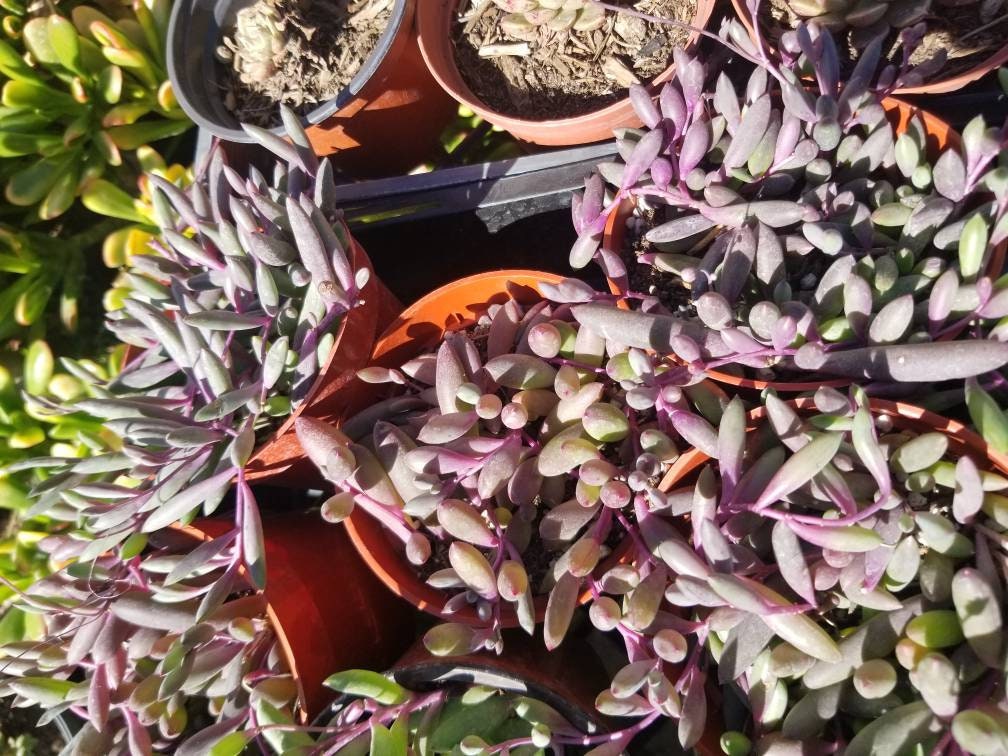Beaultiful Desert Plants
Othonna Capensis Strings of Ruby Necklace (4" Pot)
Couldn't load pickup availability
Othonna Capensis "Strings of Ruby Necklace" (4" Pot)
* Ship Bare root (without pot and soil) Pot size is only notated for your reference. * If you are going plant your cactus or succulent in a pot, have it prepared beforehand with cactus mix soil (recommended), then water lightly. *If you going to plant it into the ground, ensure proper drainage *We Only ship Priority to ensure your Succulents plant will take between 2 to 3 days to arrive, we are not responsible for any the shipping carriers are delays. * My Jades have really short roots, We reefed to the gallons that are planted in the add so you can see or estimate the actual size of the plant, do not expect to receive any Jade with long roots, That's why these trees are easy to Trim and give a shape as a bonsai tree and plant them in a shallow pot. * We try to ship our succulent plants as soon as we get the order is customer responsibility to be aware of the plant arrival also customers will get a notification by email. If the customer wants to delay or change the day of the shipment please contact us as soon as possible. *We take great care in the packaging of your plants, but unfortunately the same cannot always be said in how they are handled once they leave us .*Is the customer responsibility to purchase a (Heat pack) if the Succulent plant is ship to a cold area, we usually recommended it if the whether is 35* or lower, If you are purchasing a large succulent plant please make sure you buy enough heat pack to cover the plant (1 heat pack every 12") We are not responsible for damages to the Succulent plant if is NOT enough coverage of the heat pack, and if is delay by USPS, the heat only will keep the box warm for 72 hours.
Strings of Ruby necklace The Ruby Necklace Plant (Othonna capensis) is a fast-growing succulent that is very attractive due to its two-toned stems and leaves. Ruby Necklace Plant also called string of rubies, is a trailing succulent that can also be used in ground cover and rock gardening. The Ruby Necklace Plant is native to South Africa. Like other trailing succulents, Ruby Necklace Plant is very easy to care for. The less we care about them, the better they are. Minimal maintenance and low watering make it the perfect hanging succulent near windowsills. Botanical Name Othonna capensis Common Name String of rubies, Ruby Necklace Plant, string of pickles, Ruby Necklace Succulent Plant Type String Succulent Mature Size 2 inches tall Sun Exposure Direct sun Soil Type Well-draining, cactus/succulent soil Soil pH 6.0-6.5 Bloom Time Spring, summer, fall How to Grow Ruby Necklace Plant (Othonna capensis) The ruby necklace plant is similar to other Succulents that are easy to propagate. Ruby Necklace Plant propagation can only be accomplished with stems, hydrotherapy and seeds. When breeding is successful, you can sell or give the othonna capensis to your loved ones. In addition, you can sell a large othonna Capensis. The best time to breed Ruby Necklace Plant is spring and autumn. Ruby Necklace Plant Propagation with Seeds Ruby necklace plant (Othonna capensis) seed propagation can be done, and growing Ruby Necklace Plant from seeds is a very simple process. Seed pods are located at the tips of completely dried flowers and should be removed carefully. Sterilize dry soil in the microwave for 90 seconds. This will kill harmful bacteria. Dry the succulent seeds of the Ruby Necklace Plant and plant them under the top layer of the soil. Place in indirect sunlight or growth light. Cover the soil with a plastic or glass lid to retain moisture. After a month, it will grow young saplings that can be transferred to a larger pot. Ruby Necklace Plant Propagation with Stem Cuttings The Ruby Necklace Plant (Othonna capensis) is very easy to propagate by stems. Just cut with a clean, sterilized cutting tool and let it harden for an hour or two. Use rooting hormone when potting in soil. During reproduction through the stem, fragile leaves may be shed from the stem.
Share










Subscribe to our emails
Be the first to know about new collections and exclusive offers.










